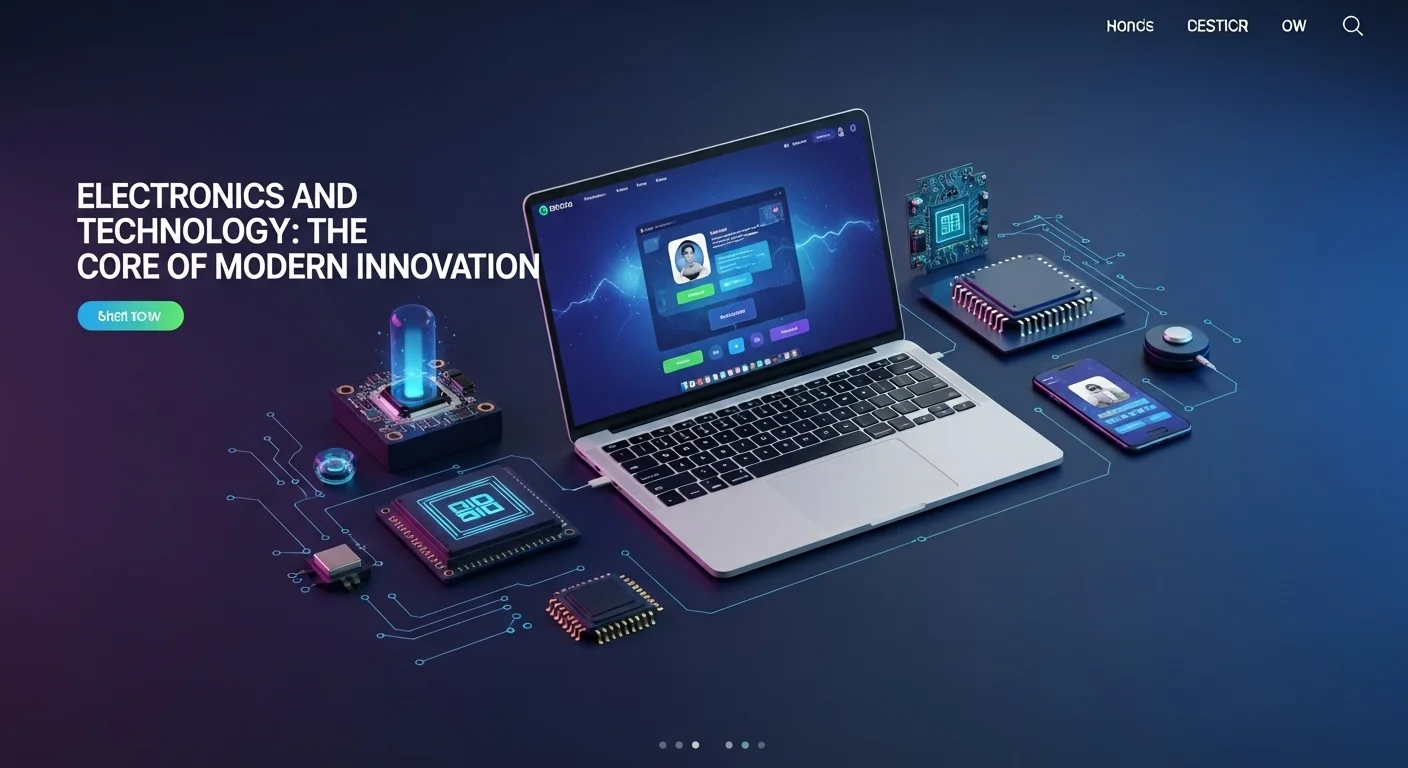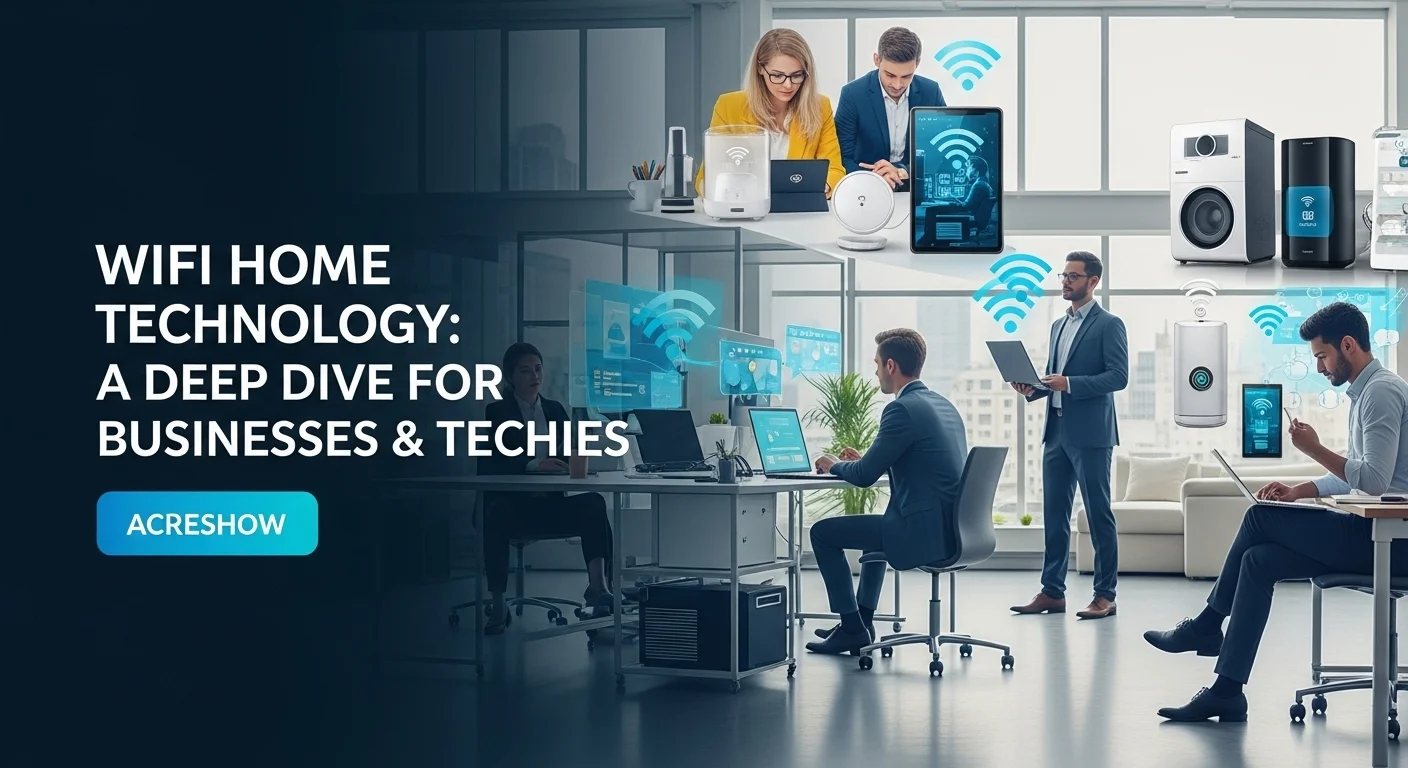How Electronics Quietly Powers Your World: A Guide for Innovators

Executive Summary
After more than twenty years in electronic engineering, I've seen this field evolve from a specialist's niche to the literal backbone of our society. It's not just about the gadgets in our pockets; it's the silent engine of global business, the vigilant guardian of our homes, and the key to a more efficient future. In this guide, I'm going to pull back the curtain and walk you through the core concepts. We'll explore how everything from massive power grids to your smart thermostat actually works, and more importantly, how you can start harnessing this incredible power to achieve your own goals, whether you're a business leader or just a curious tech enthusiast.
Table of Contents
Table of Contents
What is Electronics and Why Does It Matter?
Let's be honest, we all use the word 'tech' every day, but we rarely talk about what's actually making it all happen: electronics. To really get a grip on the digital world, you have to understand this foundational layer. In the simplest terms, electronics is the science of controlling tiny electrical currents to get a job done. I've often had to explain the difference between 'electrical' and 'electronic'. Think of it this way: electrical science might power a whole city, like a massive, brute-force flow of energy. Electronics, on the other hand, is about finessing that energy on a microscopic scale to process information. It’s the difference between a lightning bolt and the microprocessor in your phone that lets you read this article. Electronics is the physical hardware that brings software to life and builds the interconnected world we live in.
At the heart of this entire field are components that, frankly, changed the course of human history. The star of the show is the semiconductor. Materials like silicon have a special property—they're not great conductors, but they're not great insulators either. By adding impurities in a process we call 'doping,' we can precisely control how they conduct electricity. This breakthrough led to the transistor, which I believe is the most important invention of the 20th century. A transistor is just a tiny, reliable switch. By packing billions of these switches onto a single sliver of silicon, we create an integrated circuit (IC), or a microchip. These chips are the 'brains' in every modern device. The relentless drive to make these transistors smaller and smaller, a trend known as Moore's Law, is what has given us this incredible explosion in computing power, making technology faster, cheaper, and more powerful year after year.
The Architects of Our Digital World: Electronic Engineering
The people who design and build these incredible systems are electronic engineers. I've spent my career in this field, and it's a discipline that sits at the crossroads of physics, math, and creativity. We design, test, and oversee the creation of everything from the guts of the next iPhone to the control systems in a self-driving car or the life-saving MRI machine at a hospital. Our work covers both analog electronics (think continuous signals, like a sound wave) and digital electronics (the world of 1s and 0s). But being an electronic engineering professional isn't just about single components. It's about system integration—knowing how to make a processor, memory, sensors, and a power source all work together flawlessly inside a single, efficient product. We are the architects of the hardware that runs the world, turning abstract scientific principles into the tangible technology you use every single day.
The Unsung Hero: Why Power Electronics is Crucial
If microelectronics is the brain, then power electronics is the heart and circulatory system. This is a sub-field I'm particularly passionate about because it's so fundamental, yet so often overlooked. It deals with efficiently converting and controlling electrical energy. Every time you plug your laptop into the wall, you're using a small marvel of power electronics. That little brick on the cord is converting the high-voltage AC from your outlet into the low-voltage DC your computer needs. But it goes so much further. In renewable energy, power electronics are what make solar panels and wind turbines useful, converting their raw power into stable energy for the grid. In an electric vehicle, it's the system that manages the immense power flowing from the battery to the motor. In my experience consulting for data centers, I've seen how these systems are the key to both reliability and efficiency, saving millions in energy costs. As we push for a more sustainable and electrified world, the innovations in power electronics are becoming absolutely critical.
Bringing It Home: Smart Security and Control
Nowhere is the impact of electronics more personal than in our homes. The modern electronic home security system is a perfect case study. It's a symphony of electronic parts: motion sensors, contact sensors on doors, HD cameras streaming video to your phone, and a central panel that coordinates everything. This is applied electronics in a nutshell: sensors provide input, a processor makes a decision, and an alarm or a notification provides the output. The reliability of these home electronic security systems is a direct result of decades of progress in microchips and wireless tech.
Beyond just security, we now have the home electronic control system, or what everyone calls a 'smart home'. This is about weaving control into the fabric of your house—lights, thermostat, music, and even appliances, all networked together. With a simple voice command, you can dim the lights, turn up the heat, and lock the front door. This isn't just about convenience; it's a powerful tool for managing energy. A smart thermostat that learns your schedule can save a surprising amount on your heating bills. The backbone of any good home electronic control system is a network of sensors and controllers, all made possible by advanced electronic engineering. It shows how electronics has matured from being in our gadgets to being part of our environment, making it safer, more comfortable, and more efficient.

Putting Electronics to Work: A Practical Guide for Businesses
Electronics have completely rewritten the rules of business. I've seen companies transform their operations and create entirely new markets by smartly applying electronic solutions. For any modern business, understanding how to use this technology is no longer optional—it's essential for survival and growth. This isn't just for tech companies; it's for manufacturers, retailers, and farmers alike. Let's look at the real-world methods and strategies that allow businesses to harness the power of electronics.
At its core, business technology relies on both analog and digital systems. Analog electronics are our bridge to the physical world—they're in the sensors that measure temperature in a server room or pressure in a hydraulic line. That real-world data is then converted into digital form, the language of 1s and 0s that computers understand. This combination is where the real power lies. I remember working with a food processing plant where an analog sensor would detect the temperature of a cooking vat. That signal was converted to digital, fed into an industrial computer (a PLC), which then sent a command to shut off the heat at the perfect moment. That simple loop improved product consistency, enhanced safety, and reduced energy waste—a perfect example of modern industrial automation.
Technical Methods in Business-Oriented Electronic Systems
When businesses want to build their own unique solutions, they turn to electronic engineering. A huge area here is embedded systems. An embedded system isn't like your desktop PC; it's a dedicated computer designed for one specific job, like managing the engine in a car or operating a smart coffee maker. My colleagues in electronic engineering specialize in designing these systems to be incredibly reliable, low-power, and affordable to produce. For a business, adding a well-designed embedded system can make their product 'smart,' creating a better user experience and a major advantage over competitors.
Then there's the critical role of power electronics. For any business with physical operations, energy is a huge expense and a potential point of failure. I once consulted for a mid-sized data center that was struggling with high electricity bills. By implementing high-efficiency power supplies and a modern uninterruptible power supply (UPS) system—both marvels of power electronics—we not only secured their data against outages but also cut their energy costs by nearly 15%. That's a direct impact on the bottom line. In manufacturing, using variable frequency drives (VFDs) to control industrial motors can slash energy use by ensuring the motor only works as hard as it needs to, which also reduces wear and tear on expensive equipment.
Business Techniques for Leveraging Electronics
Having the tech is one thing; using it strategically is another. One of the most powerful techniques today is making decisions based on data gathered from the Internet of Things (IoT). By placing small, connected sensors on everything from delivery trucks to farm equipment, companies can get a real-time view of their entire operation. A logistics firm can optimize delivery routes on the fly, and a farmer can use soil sensors to water and fertilize with incredible precision. The electronics are the enablers, but the business strategy is to analyze that data to find efficiencies and opportunities.
Another game-changing model driven by electronics is Product-as-a-Service (PaaS). Instead of just selling a piece of hardware, a company sells the service it provides. For instance, an industrial air compressor manufacturer might sell 'cubic feet of compressed air' instead of the machine itself. They install and maintain the equipment, packed with electronic sensors that monitor its health and performance, and the customer pays a subscription fee. This creates a long-term partnership where the manufacturer is incentivized to make their product as reliable and efficient as possible. It's a brilliant way to turn a hardware company into a service provider with recurring revenue.
Case Study: The Business of Home Security and Automation
The home automation market is a masterclass in how to turn electronic systems into a thriving business. A modern electronic home security system is a sophisticated product. The hardware has to be top-notch, but the user-friendly software and the recurring revenue from monitoring services are where the real business is. Companies like SimpliSafe or Ring have succeeded by building a seamless ecosystem. When you buy their doorbell camera, you're much more likely to buy their indoor cameras or sensors because you know they'll all work together perfectly from a single app. This 'walled garden' approach dramatically increases the value of each customer.
Likewise, the larger home electronic control system market is a battle of platforms. Giants like Amazon (Alexa), Google (Home), and Apple (HomeKit) want to be the central 'brain' of the home. For a company making smart light bulbs or thermostats, the most important business decision is ensuring their product works with these platforms. This requires technical partnerships and rigorous certification. A failure to integrate is a failure to compete. These platforms also provide invaluable, anonymized data about how people live. This insight, when used ethically, can drive the development of new products people actually want. The success of both home electronic security systems and control platforms is a testament to combining brilliant electronic engineering with smart, ecosystem-focused business models.

Your Electronics Playbook: Tips for Today and Tomorrow
As electronics weave themselves ever deeper into our lives, knowing how to manage this technology is no longer just for the experts. Whether you're trying to build a smarter home or a more competitive business, a strategic approach is key. It's about choosing the right tools, using them securely, and planning for the future. And believe me, the future is coming fast, with AI, IoT, and sustainable energy set to change the game once again. Here are some practical tips and strategies I've gathered over the years to help you get the most out of your tech.
Best Practices for Your Home
For your home, implementing a home electronic control system can be incredibly rewarding, but a little planning goes a long way. Here’s my advice:
1. Start with a Goal, Not a Gadget: Before you buy anything, ask yourself what you really want. Is it to save money on energy? Boost your home's security? Or just for convenience? If your goal is saving energy, a smart thermostat is a great first step. If it's security, focus there first. A clear goal prevents you from ending up with a drawer full of incompatible smart plugs.
2. Build on a Secure Foundation: Your Wi-Fi router is the front door to your smart home. Secure it. Please, change the default password, use strong WPA3 encryption, and maybe even create a separate network for your IoT devices. Every smart device you add is another potential door, so change its default password during setup, too.
3. Pick an Ecosystem: To avoid juggling dozens of different apps, it's wise to stick to one main ecosystem like Google Home, Amazon Alexa, or Apple HomeKit. This lets your devices talk to each other, which is where the real magic happens. You can create a 'Good Night' routine that locks your doors, turns off all the lights, and lowers the thermostat with one command.
4. Don't 'Set It and Forget It': Smart devices need maintenance. Keep their software updated, as these updates often fix critical security flaws. This is non-negotiable for your electronic home security system. The integrity of home electronic security systems relies on the latest software to fend off new threats. Also, remember to check batteries in sensors and wipe dust off camera lenses.
Strategies for Businesses
For a business, electronics are a strategic asset. Thinking about them that way can unlock huge potential.
1. Manage the Full Lifecycle: Businesses have a ton of electronic gear. Develop a smart plan for buying it, but also for getting rid of it. E-waste is a serious problem. Partnering with a certified recycler for old equipment isn't just environmentally responsible; it's a good look for your brand.
2. Invest in Rock-Solid Power: I can't stress this enough: downtime kills a business. Quality uninterruptible power supplies (UPS) are cheap insurance against power flickers and outages. For bigger operations, a power electronics audit by an electronic engineering firm can uncover massive energy savings. I've seen these investments pay for themselves in under two years through lower electricity bills.
3. Build or Borrow Expertise: Technology changes in the blink of an eye. You need access to expertise in areas like electronic engineering and cybersecurity. You can build this team in-house, or for many businesses, it makes more sense to partner with specialized consultants or Managed Service Providers (MSPs).
4. Use Electronics to Innovate: Don't just think of electronics as a cost. How can they create a new service? Could you add sensors to your product to predict when it needs maintenance? The most successful companies I've worked with use electronics as a core part of their business strategy, not just their IT department. A great place to stay informed on what's possible is the IEEE Spectrum, a publication I've read for years.
What's on the Horizon?
Looking ahead, a few trends are set to completely redefine electronics.
- AI on the Device ('Edge AI'): We're moving away from sending all data to the cloud for AI processing. The next wave is powerful, efficient chips that run AI right on the device. This means faster, more private, and more reliable smart technology—from a security camera that can tell the difference between a person and a raccoon, to a medical sensor that can detect health issues in real-time.
- The Push for Sustainable Electronics: The industry is finally getting serious about its environmental footprint. Researchers in electronic engineering are developing new, greener materials. Companies are designing products that are easier to repair, not just replace. And power electronics is at the very heart of the renewable energy transition.
- Truly Intelligent Homes: The future home electronic control system will be proactive, not reactive. It will learn your family's routines and subtly adjust the lighting, climate, and ambiance for you. Your electronic home security system will use AI to give you truly meaningful alerts, not a dozen notifications because a cat walked by. It's a future where our environment responds to us, all powered by the quiet, constant hum of electronics.
Expert Reviews & Testimonials
Sarah Johnson, Business Owner ⭐⭐⭐
Good overview, but as a business owner, I was hoping for more practical, real-world examples I could apply directly.
Mike Chen, IT Consultant ⭐⭐⭐⭐
A helpful article on electronics. It clarified a lot for me, though some of the technical concepts could have been broken down a bit more simply.
Emma Davis, Tech Expert ⭐⭐⭐⭐⭐
Excellent and comprehensive article on electronics! This was a huge help for my specialization. Everything was explained perfectly.



